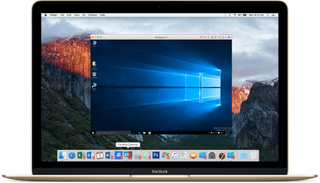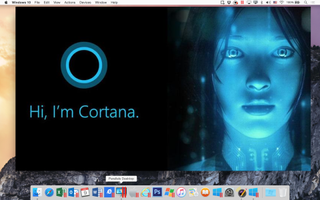Parallels 11 Brings Windows 10, Cortana Support To Macs

Parallels is a program for Macs that allows its users to install other operating systems, such as Windows, Linux and Chrome OS to work in conjunction with their OS X systems. In February, the company brought users up to speed by allowing the program to work with the Windows 10 Technical Preview. With Windows 10 finally out, the company released three versions of Parallels 11, a base version, a Pro edition and a Business edition.
In addition to new features, Parallels boasted that the latest version of its virtualization technology also boosts performance in a few areas. The launch and shutdown time for Windows is 50 percent faster. There's a 20 percent improvement in file operations in Windows and the overall performance of Travel Mode, which is activated when the MacBook is not connected to power. Version 11 also boosts the battery life by 25 percent by turning off parts of the system that would otherwise drain large amounts of power.
For the casual user, there's the base version of Parallels 11. One of the most notable features in this new version actually comes from Windows 10. The Cortana assistant now works with Mac programs, even if Windows 10 is not the system currently in use. Microsoft already had a plan in the works to bring Cortana to iOS, but Parallels seems to take it one step further by integrating it with the Mac OS. Other features in the basic version include:
- Quick Look for Windows, which extends the Mac convenience to Windows documents and files.
- New Force Touch gesture support that enables a quick preview of files with Quick Look or the ability to look up the definition of an unknown word.
- Improved Mac Window Controls include a new Coherence mode button.
- The most recently used files list now can be viewed on the Mac regardless of where those files are stored (they can be on OS X, in a virtual machine, in the cloud or on a file server).
- New printing with all Mac printer options support aims to save users time.
- "New Item" support for the creation of new files in Windows apps, including Outlook, Excel and Word.
- Easily cancel time-consuming virtual machine actions.
- Mac location services are now available to Windows applications.
- Automatic synchronization of the volume setting of a virtual machine with that of the Mac.
- Enhanced file associations with smart notification messaging help change file association in OS X.
- Improvements in the setup and use of a virtual machine to directly access a Boot Camp Windows partition without having to reboot.

There's also a Mac Pro Edition of Parallels, which is targeted at productivity users, developers and designers. Obviously, they also receive the same package as the base Parallels 11 version, but there are a few extras including:
- Integration with key developer tools, such as Docker, Visual Studio (via a plug-in), Chef and Jenkins.
- Support for Vagrant and other developer tools.
- Additional user profiles for developers, power users and testers for optimal configuration for their particular scenarios.
- Advanced networking tools and configuration for virtual networks to test complex networking scenarios, including the ability to simulate some network instabilities.
- Cloud storage access through Box, Dropbox for Business and OneDrive Business, for sharing from Windows to Mac.
- Headless mode for running virtual machines in the background without a user interface.
- Ability to create linked clones to conserve disk space and optimize installations.
- Enhanced memory (64 GB RAM) and processing power (16 vCPU) for improved performance.
- Nested virtualization for Linux guests.
- Modern.IE test environments in the Parallels New Virtual Machine Wizard, which provide access to free trials of browsers for testing.
- 24/7 phone and email support.
Finally, there's the top-tier model, the Mac Business Edition. As the name suggests, this option is for IT professionals in the workplace. It includes both the basic and Mac Pro Edition features as well as a few of its own including a web-based Parallels License Management Portal that carries only one activation key in order to make the management of multiple license keys easier and capabilities that keep administrators in control of virtual machines.
Despite its many features, there's still the issue of price. The base model is priced at $79.99 while the Mac Pro Edition and the Business Edition have yearly subscriptions, both at $99.99. Fortunately, there's another option. Apple recently announced Windows 10 support via Boot Camp so all you need to do is have a compatible Mac product and the Windows 10 software via a USB drive, installation disc or as an ISO file.
Follow Rexly Peñaflorida II @Heirdeux. Follow us @tomshardware, on Facebook and on Google+.
Stay on the Cutting Edge
Join the experts who read Tom's Hardware for the inside track on enthusiast PC tech news — and have for over 25 years. We'll send breaking news and in-depth reviews of CPUs, GPUs, AI, maker hardware and more straight to your inbox.
-
Jerahmia Wood Or you could just use Oracles Virtualbox (Available for OS-X, Windows and Linux) and get 90+% of those features for free.Reply -
LordConrad Who would want to contaminate a Mac with Windows 10? I won't put Windows 10 on a PC, why ruin a good computer?Reply -
velocityg4 Parallels is such BS. Every time there is an OS update. The old version is suddenly incompatible and you have to buy a new version. It's reached the point where it is blatantly obvious they design it to be incompatible.Reply
It wouldn't be so bad if Apple didn't make a new version of Mac OS X once a year. I wouldn't be surprised if they released Parallels 12 in one or two months when 10.11 "El Capitan" is released. -
uglyduckling81 Apple's greatest feature is it has programs capable of running Windows. Why even bother with Apple honestly. I'm currently suffering using a macbook air on holidays. It feels like using Windows 3.1 but with less features. Things are unnecessarily difficult and overly complicated. I really wish someone had stolen my wife's mac instead of my cheaper, more powerful, and more intuitive windows laptop. I guess the thief had used a mac before as well.Reply -
McHenryB VirtualBox on OS X has always had the problem (unless they've fixed it recently) that it uses 100% of the Mac's CPU (or at least as many cores as you allocate to the VM) all of the time. I don't know about Parallels, but VMWare Fusion doesn't suffer from this defect. I gave up using VirtualBox on my Mac, and shelled out for Fusion, because I felt it just wan't suitable for the job.Reply -
cwolf78 Anyone else appreciate the irony that they want Mac users to pay $80-100/yr to run a piece of software that most PC users are getting for free?Reply -
bloc97 ReplyI really wish someone had stolen my wife's mac instead of my cheaper, more powerful, and more intuitive windows laptop. I guess the thief had used a mac before as well.
Hahaha, I don't know if it was a joke or not, but that really made my day.
Most Popular






